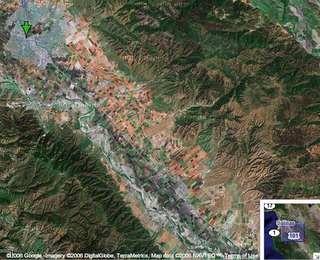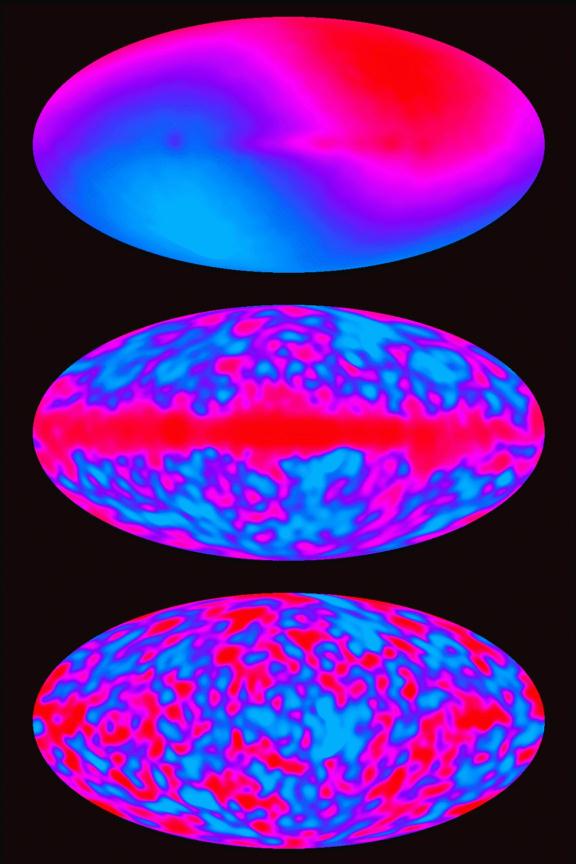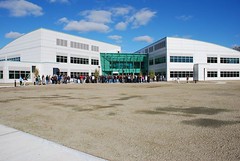When I first arrived at BNL in the late 1990's I was in some awe of the place, but I was always a little let-down by how run-down many of the buildings were. I appreciate that scientists are practical people, so if the building still stands and people are getting work done, then why worry? But I also am somewhat of a stickler for a well-thought-out environment and so it's nice to see refreshes of ones surroundings here and there. And BNL hasn't really had one since the 1970's as far as I can tell, most of the main office buildings being built between the 40's and 60's (including Chemistry, where I still work for the moment).
Anyway, all of this is to express my appreciation to the DOE for funding a spanking-new addition to BNL architecture (a long neglected field of study): the Research Support Building. This lab is going to be around for quite a while yet, and it deserves structures that send out that message (the nanoscience building is next...).
Only one thing missing: the smell of freshly-brewed coffee in the atrium. Hopefully more on that some other time.
Monday, October 30, 2006
Wednesday, October 25, 2006
Nashville
I'm back from Nashville, at last. It was an interesting trip, and I have a few photos to show for it.
Monday, October 23, 2006
Boy in the Bubble
 Yow, way behind on blogging again. Not that I haven't been up to anything, but it would take me all day just to recap the last couple of weeks. Suffice it to say that I've done a few things I've never done before: bike 60 miles, get engaged, and go to Nashville, where I am now. I can tell you which one was my favorite, and staying here in a bubble is not one of them! I am attending the meeting of the "Topical Group on Hadron Physics", where I gave a talk yesterday, but I'm heading home tomorrow to get back to my real life. It's hard to explain the effect of living inside a huge (63 acre) hotel where you can walk for 15-20 minutes (which I often had to just to change sessions) without ever going outside. It's apparently the closest to a Vegas hotel you can get without actually hitting the casinos (I've never been to Vegas so I have to take the world's word for this).
Yow, way behind on blogging again. Not that I haven't been up to anything, but it would take me all day just to recap the last couple of weeks. Suffice it to say that I've done a few things I've never done before: bike 60 miles, get engaged, and go to Nashville, where I am now. I can tell you which one was my favorite, and staying here in a bubble is not one of them! I am attending the meeting of the "Topical Group on Hadron Physics", where I gave a talk yesterday, but I'm heading home tomorrow to get back to my real life. It's hard to explain the effect of living inside a huge (63 acre) hotel where you can walk for 15-20 minutes (which I often had to just to change sessions) without ever going outside. It's apparently the closest to a Vegas hotel you can get without actually hitting the casinos (I've never been to Vegas so I have to take the world's word for this).Anyway, Nashville itself is pretty neat: the honkytonks really look and act like I hoped. Stay tuned for photos.
Friday, October 13, 2006
Google does Units
 Speaking of Google, a colleague pointed out that the search engine knew what a GeV was -- in joules. I wanted to check if it knew how to combine units, and do a bit of quantum mechanics at the same time: check. Freshman physics will never be the same, especially if they can bring their EDGE-enabled cellphones.
Speaking of Google, a colleague pointed out that the search engine knew what a GeV was -- in joules. I wanted to check if it knew how to combine units, and do a bit of quantum mechanics at the same time: check. Freshman physics will never be the same, especially if they can bring their EDGE-enabled cellphones.
Pixelization of the Landscape
 Now that experts have discovered where the deadly E Coli comes from, I wanted to get the big picture. And that comes from Google Maps of course. What blew my mind about this satellite view of the Salinas valley was the stark contrast betwen the green mountainous regions to the northeast and southwest, and the complete parcelling out of the fertile land in the valley. I first thought the satellite image had been tampered with until it became obvious that the pixelization was man-made, on gargantuan scales. Nothing incredibly deep here, but the contrast surprised me.
Now that experts have discovered where the deadly E Coli comes from, I wanted to get the big picture. And that comes from Google Maps of course. What blew my mind about this satellite view of the Salinas valley was the stark contrast betwen the green mountainous regions to the northeast and southwest, and the complete parcelling out of the fertile land in the valley. I first thought the satellite image had been tampered with until it became obvious that the pixelization was man-made, on gargantuan scales. Nothing incredibly deep here, but the contrast surprised me.
Wednesday, October 04, 2006
Accelerator in Your Pocket?
 And speaking of GeV, here's a somewhat old article pointed out in Slashdot yesterday: "From Zero to a Billion Electron Volts in 3.3 Centimeters: Highest Energies Yet From Laser-Wakefield Acceleration".
And speaking of GeV, here's a somewhat old article pointed out in Slashdot yesterday: "From Zero to a Billion Electron Volts in 3.3 Centimeters: Highest Energies Yet From Laser-Wakefield Acceleration". Impressive as this is, "It's the tip of the iceberg," says Leemans. "We are already working on injection" -- inserting an already energetic beam into an accelerating cavity -- "and staging," the handoff of an energetic beam from one capillary to the next and subsequently to others, until very high energy beams are achieved. "Brookhaven physicist Bill Weng has remarked that achieving staging in a laser wakefield accelerator would validate 25 years of DOE investment in this field."Holy crap.
Leemans's group and their collaborators look forward to the challenge with confidence. "In DOE's Office of Science, the High Energy Physics office has asked us to look into what it would take to go to 10GeV. We believe we can do that with an accelerator less than a meter long -- although we'll probably need 30 meters' worth of laser path."
How Jets were Born
 Amidst this interesting article in the science times yesterday on the issues faced by women in science, and physics more specifically, it was pointed out that Gail Hanson of UC Riverside discovered "quark jets". I have to admit that, even after being in my field for 15 years, I had never heard of anyone credited with the discovery of jets. Rather, I had always understood the "discovery" of jets to be the gradual acceptance of the phenomenon by high energy physicsts as the energy increased.
Amidst this interesting article in the science times yesterday on the issues faced by women in science, and physics more specifically, it was pointed out that Gail Hanson of UC Riverside discovered "quark jets". I have to admit that, even after being in my field for 15 years, I had never heard of anyone credited with the discovery of jets. Rather, I had always understood the "discovery" of jets to be the gradual acceptance of the phenomenon by high energy physicsts as the energy increased.Of course, I was wrong. And I'm probably the last to realize this, since she's already won a Panofsky prize for this work.
Here's the link to the article on "Evidence for Jet Structure in Hadron Production by e+e- Annihilation" from Gail Hanson's website. Not only is this the first time anyone established the "jettiness" of hadrons emerging from the annihilations of electrons and positrons at "high energies" (6-7 GeV in this case), but there's actually a "first author" on this paper (Hanson herself), something which never happens anymore in high energy or nuclear physics anymore!
Tuesday, October 03, 2006
Ready for the Prize?
 You can feel it in the air in early Autumn: the imminence of the Physics Nobel Prize announcement. I had just arrived at CERN this morning (after a major move from upper Manhattan to Chelsea...long story) when the announcement appeared. The COBE guys have finally gotten their due, and I suppose the huge success of the WMAP program, which is nominally "better", justified the lasting influence of the earlier measurements. However while year-after-year, I am consistently surprised by the choices (both in their content and timing), this year's lucky pair sounded somewhat prepared:
You can feel it in the air in early Autumn: the imminence of the Physics Nobel Prize announcement. I had just arrived at CERN this morning (after a major move from upper Manhattan to Chelsea...long story) when the announcement appeared. The COBE guys have finally gotten their due, and I suppose the huge success of the WMAP program, which is nominally "better", justified the lasting influence of the earlier measurements. However while year-after-year, I am consistently surprised by the choices (both in their content and timing), this year's lucky pair sounded somewhat prepared:Smoot: ''The discovery was sort of fabulous. It was an incredible milestone. Now this is a great honor and recognition. It's amazing,'' he said.
Mather: "I can't say I was completely surprised, because people have said we should be awarded, but this is just such a rare and special honor,'' Mather said in a telephone interview with the Nobel committee.
Subscribe to:
Comments (Atom)



